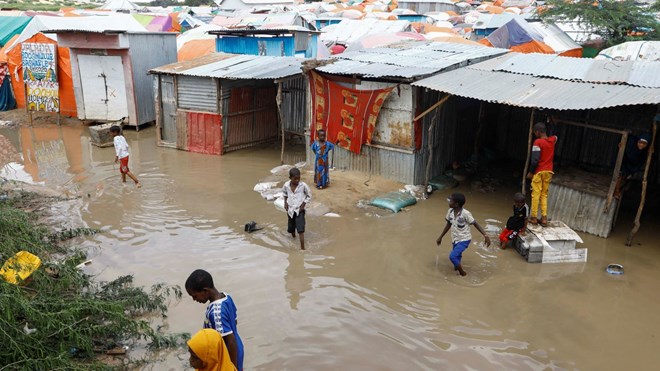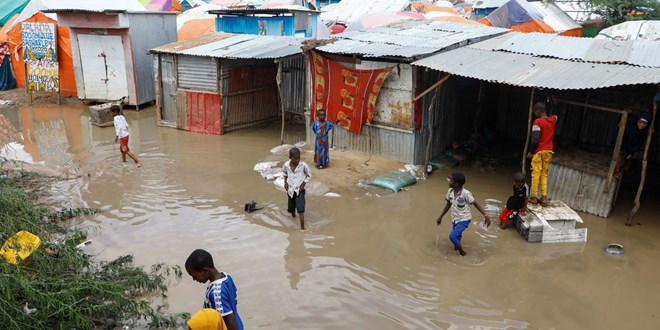[ad_1]

By Bethlehem Feleke and Nimi Princewill, CNN
Tuesday December 5, 2023

Severe flooding caused by a combination of the El Nino and Indian Ocean dipole weather phenomena has killed hundreds of people in East Africa since seasonal rains began in October. Feisal Omar/Reuters
Torrential rains and flash floods have ripped through parts of East Africa for several weeks, killing more than 350 people and displacing over 1 million across Somalia, Kenya, Ethiopia, and Tanzania.
In Kenya, at least 136 have died and nearly half a million have been displaced, according to the Interior Ministry. Persistent rains since October have affected 38 out of 47 counties across the country, which have been hit by flash floods, general flooding, and mudslides, President William Ruto revealed in an emergency cabinet meeting last week.
The northeastern parts and the eastern coast of the country have been the worst-hit areas with severe damage to homes and infrastructure, including disruptions to cargo rail services from the port of Mombasa last month.
The unusually heavy rains are largely caused by the El Niño weather phenomenon and are forecast to continue into the new year by the Kenya Meteorological Department.
El Niño is a climate pattern that originates in the Pacific Ocean along the equator and impacts weather all over the world. This phenomenon has been associated with severe flooding in eastern Africa, resulting in landslides, elevated waterborne diseases, and food shortages. Meanwhile, the northern and southern regions of the continent often endure prolonged periods of severe drought during El Niño events.
But the Horn of Africa is also one of the world’s most vulnerable regions to climate change. While the overall amount of rain annually is expected to fall in the region the more the Earth warms, the frequency and intensity of heavy rainfall events are projected to increase. That means the Horn of Africa may experience more drought as well as floods from heavy rain.
President Ruto has activated the National Disaster Operation Center to carry out emergency response. On Thursday, the Interior Ministry announced a decrease of rainfall in northern Kenya is expected this week.
Speaking at COP28 in Dubai on Friday, Ruto captured the immediate reality and devastation of climate change as witnessed by the catastrophic rains.
“The situation in our Horn of Africa region, like many other developing countries, lays bare the harsh reality of climate change,” he said.
‘Either way people suffer’
The extreme flooding comes just months after the region suffered its worst drought in four decades.
“Some months back, we were affected by severe drought and now we are complaining about too much water. People are always feeling the stress of these two impacts,” Director of Communication for the Somali Red Crescent Society Abdulkadir Afi told CNN.
“Whether there’s less water or too much water, either way, people suffer,” Afi added.
According to the United Nation’s humanitarian agency (OCHA), the death toll from flooding has risen to 110 in Somalia and 57 in Ethiopia.
In northern Tanzania, authorities said 49 people were killed by floods accompanied by mudslides following heavy rains in the country’s Manyara province.
Up to 85 people were reported injured, Manyara governor Queen Sendiga said Monday, according to state media.
Tanzania President Samia Suluhu Hassan directed response agencies “to help rescue and prevent more disasters from happening.”
In eastern Kenya, the deluge has wreaked havoc on the Dadaab Refugee Camp, which is home to some 300,000 refugees. The camp has experienced a significant number of new arrivals over the last three years — some of them fleeing food insecurity and drought conditions in Somalia.
In November, in Hagadera, a camp inside the Dadaab complex, three out of the 15 blocks of homes were submerged, leaving around 20,000 people — about 13% of the camp — displaced and sheltering in schools and places of worship, according to the International Rescue Committee (IRC).
Surge of water-borne diseases
Aid agencies have reported surges of water-borne diseases like cholera and acute watery diarrhea due to damaged latrines and lack of access to safe drinking water.
Relief efforts to reach those in the hardest-hit areas of the camp with food, clean water and medical aid have been hindered by damaged and impassable roads, according to the IRC.
“It’s a poignant reminder of its disproportionate impact and a call to action for all of us to mobilize rapidly to address this imbalance with urgency, solidarity, and inclusivity.”
[ad_2]
